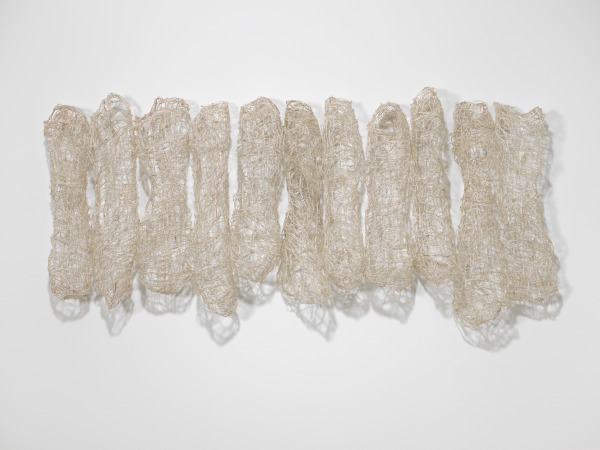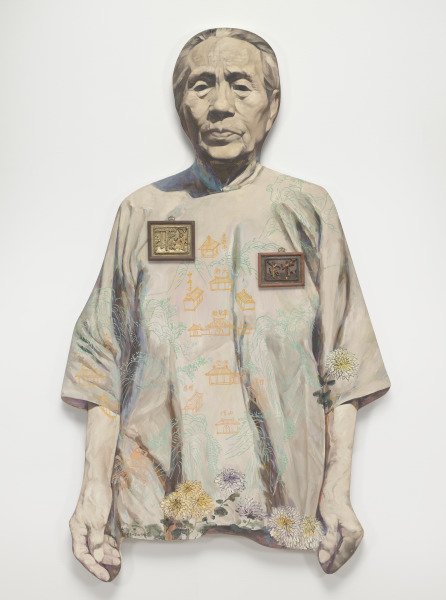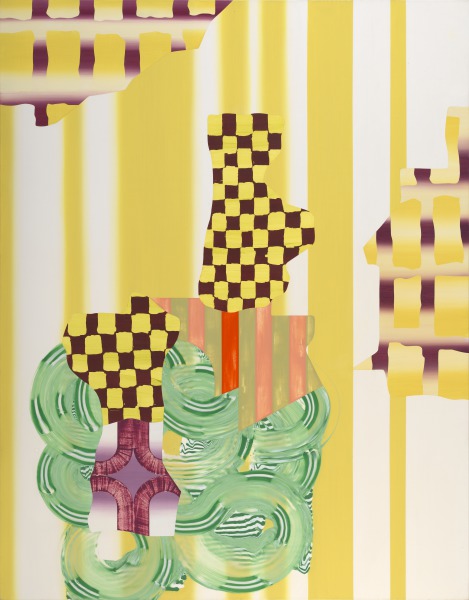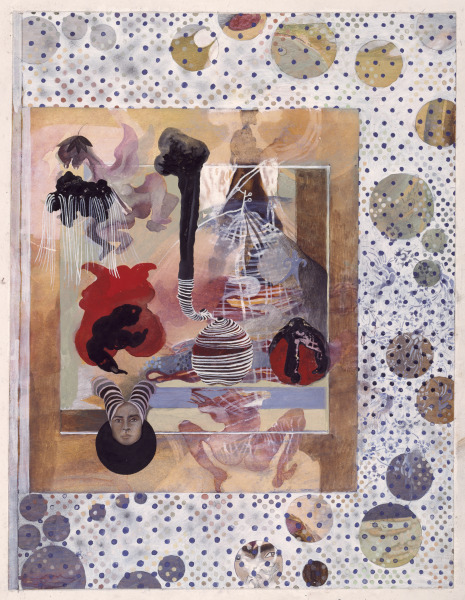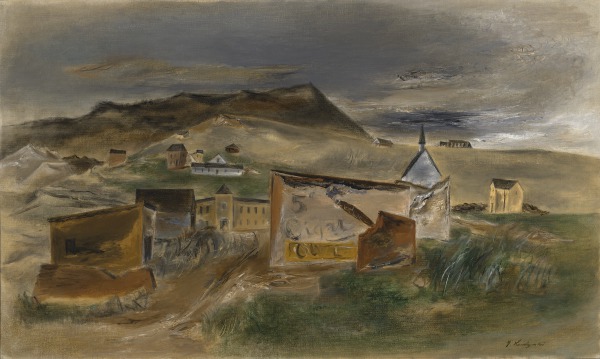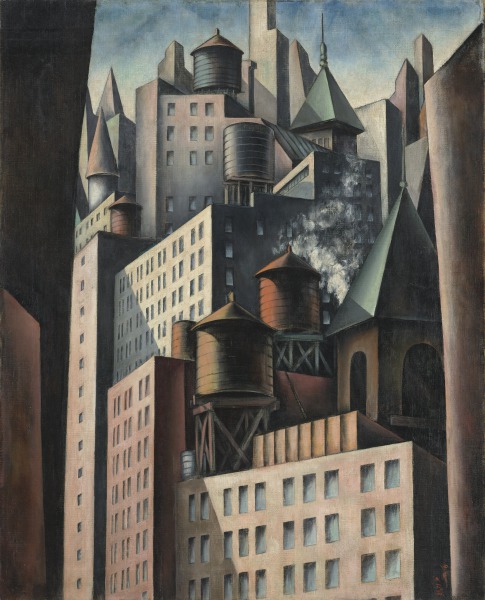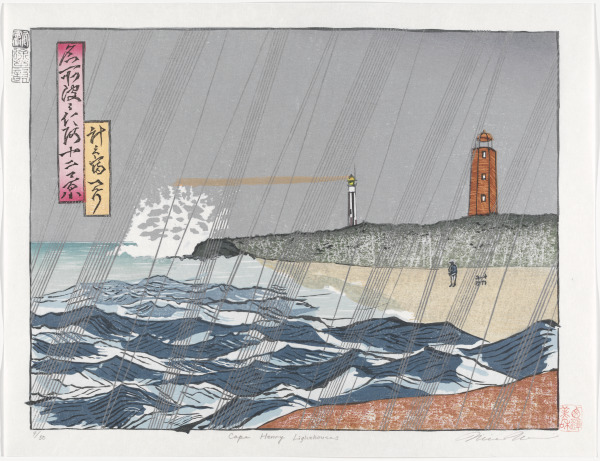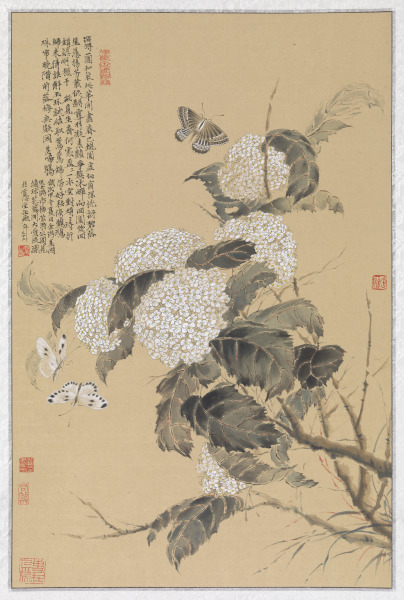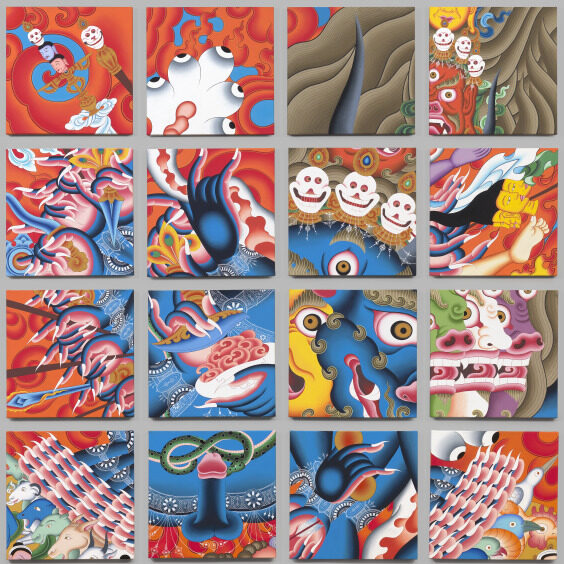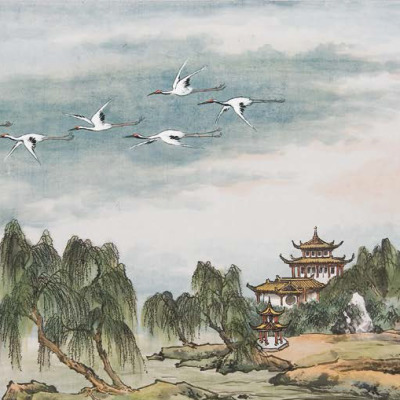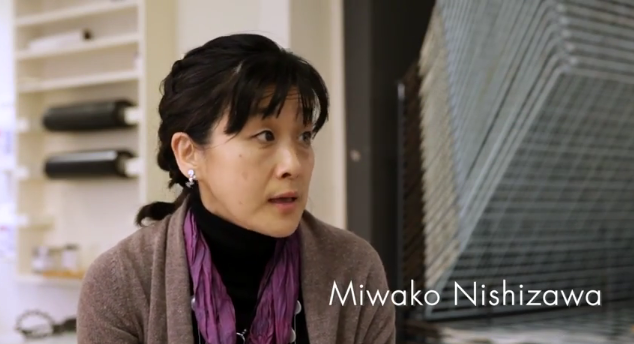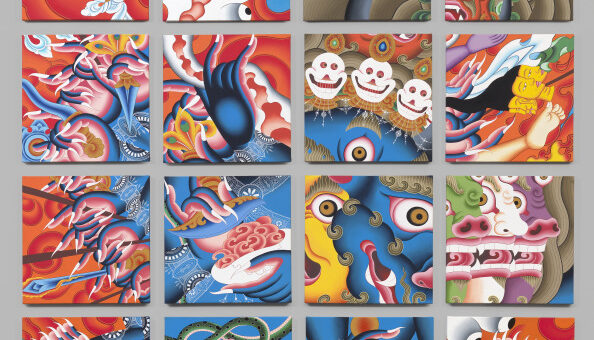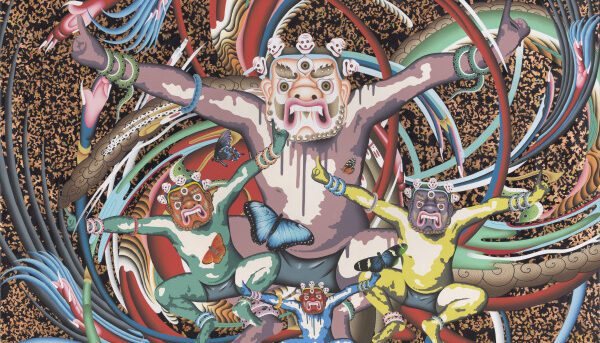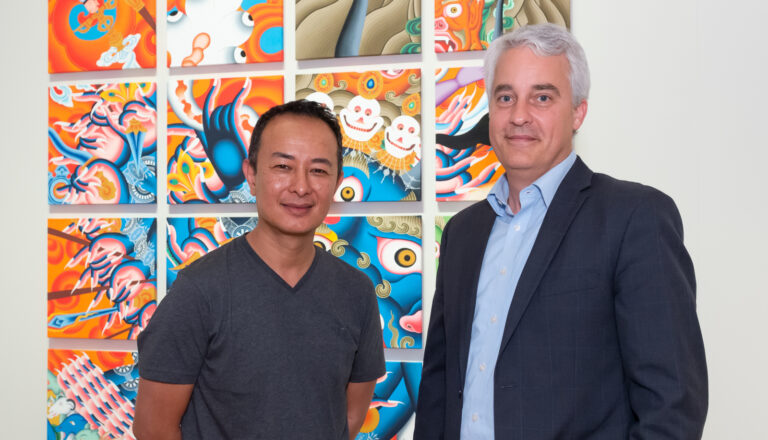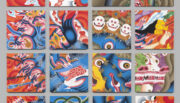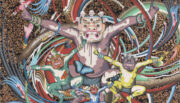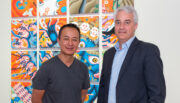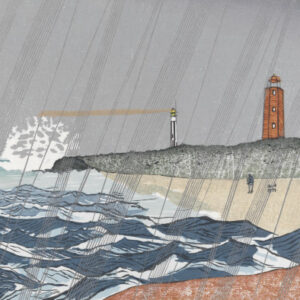
Asian American and Pacific Islander Artists at VMFA
VMFA’s permanent collection includes works by Asian American and Pacific Islander artists who have who have lived or worked in America. The collection includes artworks from twentieth-century America as well as leading contemporary artists. These artists represent a combined legacy of Asian heritage and American experience resulting in the creation of complex and layered works of art.
Please note: Works are not on view unless a gallery location is indicated.
Chrysalis Four, Kiyomi Iwata
“Fabric itself can become more intellectually challenging and I like that kind of surprise in human beings too, when you get to know each other. It is kind of nice to have layers and layers of human experience come out. That is what I enjoy very much about life and cloth.”—Kiyomi Iwata
Iwata began her career in the arts after taking a batik-dying class at VMFA’s Studio School in 1967. In the early 1970s she moved to New York where she studied weaving and textiles at the New School of Social Research. Primarily a fiber artist, Iwata uses her medium—most often silk—to push the boundaries between painting and sculpture and explore the intersection of Japanese and American artistic traditions.
Chrysalis Four marks her transition from using woven silk to form volumetric structures, like boxes, to treating kibiso thread as lines in a two-dimensional composition. Kibiso is the rough, thick silk thread produced by silk worms before they begin to make the smooth thread traditionally used in textiles. Here the loosely woven kibiso references the life stages of a silk worm, forming the shape of eleven cocoons. The transparency of the forms, however, allows each thread to cast a bold shadow, creating an intricate drawing behind the three-dimensional object.
Buddha Watching TV, Nam June Paik
“The real issue implied in “Art and Technology” is not to make another scientific toy, but how to humanize the technology and the electronic medium, which is progressing rapidly—too rapidly.”—Nam June Paik
Paik, undoubtedly the single most important figure in the history of video art, established the medium in the early 1960s. Buddha Watching TV comes from one of his most celebrated video sculpture series. Paik created the original concept in 1974 and made this example in 1997.
Here a stone Buddha head from Indonesia, partially embedded in dirt and signed dramatically across the back by Paik in Chinese and English, appears to observe itself on television. A live image of the unchanging head is continuously relayed to the monitor by the closed-circuit camera on the tripod. The Buddha thus generates and receives its own image in an infinite temporal loop, updating the act of contemplation for the age of technology.
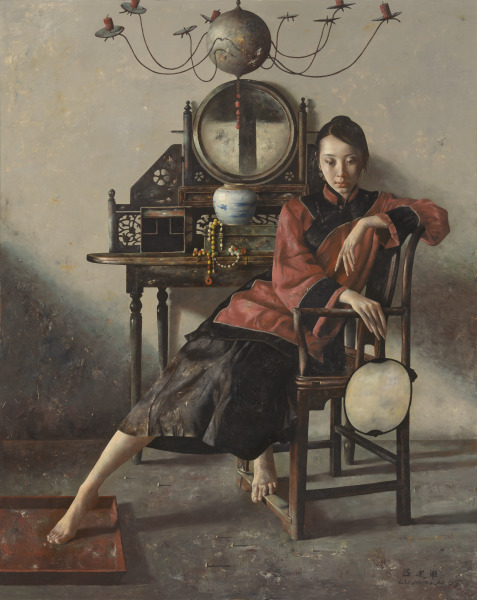
Gentle Contact, 2005, Lu Jianjun (American, born China, 1960), oil on canvas in a wooden frame. Virginia Museum of Fine Arts, Adolph D. and Wilkins C. Williams Fund, 2023.666
Gentle Contact, Lu Jianjun
East Asian Galleries, Level 2
Born in Hangzhou, southern China, Lu Jianjun studied oil paintings at Shandong Fine Art College in 1986 and at the Central Academy of Fine Arts in Beijing in 1996. After moving to San Francisco in 1999, Lu made several trips throughout the United States and Europe, where he viewed paintings by European masters in person for the first time. Gentle Contact depicts a young woman dressed in traditional clothing, sitting on a wooden chair, surrounded by traditional Chinese furniture and antique objects, such as a porcelain jar and jewelry. All this recalls the artist’s childhood visit to his mother’s hometown in southern China. The domestic details, rich color palette, and light and dark contrast reveal Lu’s classical training in oil painting and the inspiration of Flemish and Dutch artists. The sitter’s elongated hands and fingers suggest the influence of European Mannerism, an anticlassical style that emphasized idealized features.
Grandma, Hung Liu
Cochrane Court, Level 2
Hung Liu, considered one of the most important Chinese American artists, devoted her life to exploring subjects that reflect history, memory, and the lives of ordinary people. Liu moved to the United States in 1984 to pursue graduate studies at the University of California, San Diego. This portrait was created in two phases. First in 1993, Liu worked from a historical photograph of her grandmother, Wang Jushou (1890–1979). The monumental scale, dignified pose, and serene appearance all suggest the figure’s inner power and her importance to the artist. Twenty years later, in 2013, Liu added to the blouse the scenes of Mount Qianshan in northeast China, including trees, rocks, and two Zen Buddhist temples. These details pay homage to Liu’s grandfather, Liu Weihua (1894–1962), a scholar and lay Buddhist who committed his life to studying Mount Qianshan’s cultural history. The wooden panels attached to the chest depict traditional performing scenes. With compassion and insight, Liu conveys her intent of empowering working women to honor their contributions to family and society.
Disloyal Devotion, Shirley Kaneda
“It’s not that I don’t believe in the principle of unity, quite the contrary. I just don’t believe in the presence of a harmonious unity where the parts become sacrificed for the sake of it.” –Shirley Kaneda
Kaneda’s paintings address philosophical and social concepts of individuality, hybridity, and uncertainty, which refer as much to human relationships as to the rapidly changing status of images in the late 20th century. Her montage-like paintings position fragments of found and invented colors, shapes, and patterns in condensed and shifting spaces. The forms abut precariously, their artifice enhanced by sharp colors. The language of abstraction recalls New York School painting of the 1950s, but here presented as an impure subversion of that heroic modernism that might be termed a “disloyal devotion.”
Monsters Within, Shahzia Sikander
“My whole purpose of taking on miniature painting was to break the tradition, to experiment with it, to find new ways of making meaning, to question the relevance of it.” —Shahzia Sikander
Shahzia Sikander trained at Lahore’s National College of Art when it was the only school on the subcontinent still teaching Indian miniature painting as a full subject. While artists like Gulammohammed Sheikh borrowed certain narrative structures and formal elements from this genre, Sikander belongs to the first generation who returned entirely to its format and techniques—making her own paints, paper, and brushes—only to transform them in dialogue with international art. Here the traditional album-page format becomes her ground for personal expression. Combining realism, abstract pattern, and loose organic forms, the painting includes a fully modeled self-portrait of the artist at the lower left, with something like horns emerging from her head. A contorted figure crouches to her right; another abstracted squatting figure at the upper left merges human, bird, and plant forms; still other shapes vaguely resemble internal organs. This collection of bizarre oddities appears to float within cool-colored, bubble-filled margins.
Nevadaville, Yasuo Kuniyoshi
Japanese American artist Yasuo Kuniyoshi established his reputation as a leading modernist in the 1920s New York art world with images of popular amusements. Nevadaville is an example of his later imagery, marked by a somber and symbolic tone. Painted soon after the start of World War II, it depicts a western ghost town – the kind of “deserted place” the artist found himself drawn to in those turbulent years. Whereas the painting’s imagery may have originated from Kuniyoshi’s 1941 travels through California, Nevada, and Colorado, its bleak and desolate quality reverberates with wartime tensions.
In 1947, Kuniyoshi described World War II as “the backdrop for a great number of works. Not necessarily the battlefield, but the war’s implications: destruction, lifelessness, hovering between life and death, loneliness.” Nevadaville, which VMFA purchased from its 1944 exhibition of contemporary art, manifests these “implications of very sad things” as it evokes the artist’s feelings of personal displacement.
14th street, Bumpei Usui
Bumpei Usui belonged to a large Japanese American circle active in the progressive art world of New York between the two world wars. Born in Nagano, Japan, he was raised on a silkworm farm before moving to London in 1917. Usui settled in New York in1921, establishing a trade in designing furniture and frames for a wide range of clients. Through his frame work, he became interested in art and began painting.
The glowing palette, matte finish, and expressive line of 14th Street are representative of Usui’s most admired work. The picture’s subject and style suggest a precisionist approach—a term first applied in the 1920s to a diverse group of artists who favored precisely delineated form, composition, and subject matter to express the new industrial aesthetic of modernism. The precisionists took as their primary subject the simple geometric forms of machines and urban life—particularly skyscrapers.
Wine Pitcher, Komelia Hongja Okim
East Asian Galleries, Level 2
Born in Seoul and presently based in Maryland, Komelia Okim uses silver and gold metalworking techniques to create work that experiments with abstraction and Korean craft traditions. This pair of objects is modeled after customary vessels used in Korean wedding ceremonies, where wine is offered to the bride, groom, and their parents. Both components feature the traditional Korean and Chinese character “福” in gold, representing blessings for a happy marriage, and the artist’s seal in both languages as well.
Cape Henry Lighthouses, Miwako Nishizawa
Part of Nishizawa’s “Twelve Views of Virginia” series, this piece employs shin-hanga – or Japanese woodblock printing. The artist begins with a sketch, carves the design out of a woodblock – essentially creating a large stamp, coats the block in ink, and then applies the design to paper by pressing it against the block with a flat tool. According to Nishizawa, Virginia’s natural colors are similar to those in Japanese landscapes, making woodblock a fitting medium for this series. The original Cape Henry lighthouse was one of the first federally funded works of the newly formed United States government, being authorized in 1792. In 1881 a newer lighthouse was constructed 350 feet from the original. The print shows both of these structures and suggests the circular sweep of the lighthouse lamp, the chill of the storm, and the turbulence of the ocean at Virginia beach.
Hydrangea Blossoms, Shaoqiang Chen
Inspired by hydrangeas at Richmond’s own Maymont park, local artist Shaoqiang Chen depicts a natural scene and transcribes a prose written by Zhang Yan (1248-1320), in which the poet praises the beauty of flowers and the harmony between man and nature. Chen, who studied painting and calligraphy in Guangxi Province, China, specializes in landscape painting, botanic scenes, and seal carving.
Luxation I, Tsherin Sherpa
South Asian Galleries, Level 3
The son and accomplished student of a master Tibetan painter, Tsherin Sherpa left Nepal in the 1990s for California. There, he eventually began creating works that borrow elements from traditional Buddhist iconography but stretch, bend, and reconfigure them to ask new questions. The title of this painting, made after Nepal’s catastrophic 2015 earthquake, means dislocation or displacement, referencing that disaster’s devastation as well as the cultural dislocation experienced by the artist and so many Tibetans living in diaspora. As if broken and jumbled by the earthquake, sixteen pieces of a Buddhist deity are assembled into a composition whose small gaps are chasms of missing information. Particular elements are recognizable, but their sum and true significance is unclear. The goal, perhaps, is to reconstruct the full picture, an image of Vajrabhairava, a wrathful emanation of the Bodhisattva of Wisdom. Meditation upon Vajrabhairava is meant to help one conquer the fear of death.
Artist Videos
Miwako Nishizawa @VMFA
4:23Japanese-American artist Miwako Nishizawa discusses Japanese woodblock printing, her inspirations, and her work with various Virginia landscapes presented in her series “Twelve Views of Virginia,” 2014.
Curator’s Opening Talk | A Conversation with Tsherin Sherpa
1:07:22On Thursday, February 17, 2022 Dr. John Henry Rice, E. Rhodes and Leona B. Carpenter Curator of South Asian and Islamic Art participated in a conversation with artist Tsherin Sherpa. This video recording was made possible by The National Endowment for the Humanities.
3 in 30: Wrathful Himalayan Deities
33:40Explore the permanent collection of Himalayan art with Dr. John Henry Rice, E. Rhodes and Leona B. Carpenter Curator of South Asian and Islamic Art, to discover some of Tibetan Buddhism's most intense and powerful deities. This program is inspired by the special exhibition Tsherin Sherpa: Spirits.
Tsherin Sherpa: Spirits | The Artist
3:52Tsherin Sherpa visits Tsherin Sherpa: Spirits at VMFA in 2022 along with Dr. John Henry Rice, VMFA's E. Rhodes and Leona B. Carpenter Curator of South Asian and Islamic Art.
